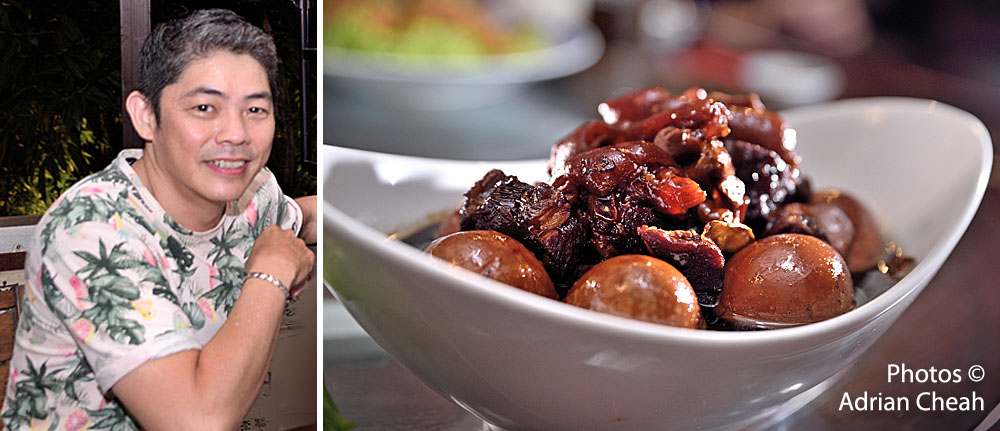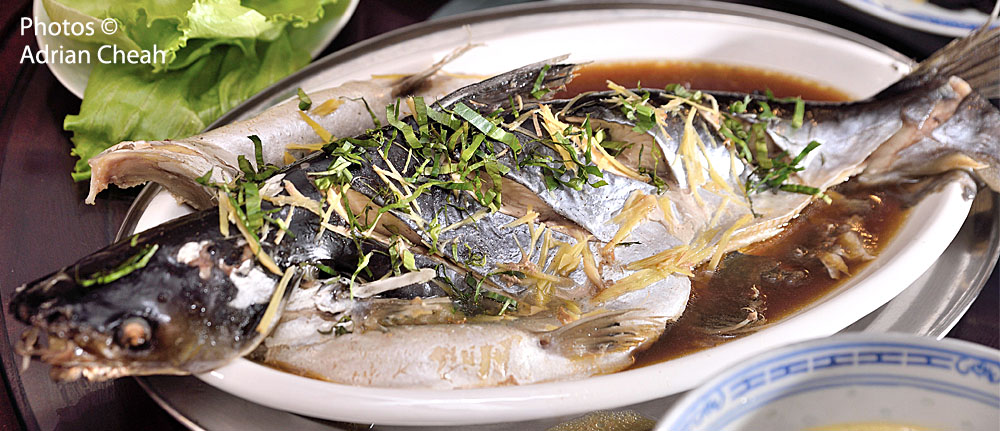Emperor Villa's "kochabi" set meals good for lunch or dinner

Emperor Villa, a family-run business offering accommodation and dining first opened its doors to the public in September 2019. It took two years to complete the construction of its rustic villas complete with a spacious swimming pool, nestled among nine acres of greenery in the hills of Sungai Ara, Penang.
"Kochabi" is a Hokkien term that means "flavours of the past", referring to recognisable homemade dishes that have been perfected by past generations. The food served at Emperor Villa is rooted in recipes handed down through the family lineage. Set meals for lunch and dinner are fixed with a soup and five dishes served with steamed white rice. The menu changes every month to entice regular customers.

The dishes enjoyed that evening included a kochabi peppered pig stomach and chicken soup. Unlike the conventional ingredients, more flavours were introduced in the soup – chicken, diced carrots, button mushrooms as well as pickled mustard plant stems – to create a sweeter and more robust-tasting soup. The long hours of simmering resulted in a highly nourishing and comforting opaque soup. I enjoyed the bold peppery kick and the tender slices of the pig stomach that made this soup a winner.

Also served that day was braised pork belly with taro, a popular Hakka speciality. The alternating layers of tender pork belly and fluffy taro with a distinct seasoning resulted in an amazingly rich and tasty dish. During marinating, the ingredients and spices were given ample time to penetrate the meat and taro. It also took at least two to three hours of steaming for the meat to be so tender as to melt in every mouthful. Hearty, comforting and intensely savoury, this dish hit all the right classic notes of Hakka cuisine.

The kochabi bangkwang char (stir-fried yam bean), a typical Nyonya dish, was served with fresh lettuce and a fiery sambal belacan on the side. The flavours in the bangkwang char were down-to-earth and uncomplicated, sans any overpowering or pungent elements (common in Nyonya cooking). The natural sweetness of the vegetables used was allowed to shine through. To provide a pleasant umami presence to the dish, finely julienne dried cuttlefish was added. This is one of my family's favourite dishes to cook at home and being very familiar with the flavours, I must add that the quality of the bangkwang char served at that dinner was top notch. Wrapping a little in a crispy lettuce leaf and topping it with a dollop of sambal belacan was a delicious mouthful experience.
If I had to change a dish in the spread, it would have to be the bangkwang char. Something crispy like choon piah would have added more texture to the ensemble while maintaining almost a similar taste to bangkwang char. A good spread of dishes will have to titillate all the tastebuds, be visually appetising and offer a variety of textural experiences. The crunchy sound of biting into something crispy is irreplaceable.

The pig trotters in black vinegar was simply scrumptious as well. The combination of sweet, sour and savoury tastes was well balanced. The moist and tender cuts of pig trotters, as well as the hard-boiled eggs, was such a joy to indulge in. This is a dish I would also cook at home. I love the spicy and crunchy flavours of aromatic young ginger and would use a good amount in my cooking. I would also add old ginger for extra spiciness and "burning heat" although old fibrous ginger is not edible.

Crisp and chewy bamboo shoots are freshly erupting edible clumps of the bamboo plant. The cone-shaped shoots are commonly used in Southeast Asian cuisine. Although they are a powerhouse of proteins, carbohydrates, fibre and minerals, bamboo shoots should first be boiled, then reboiled to remove the toxic taxiphyllin, a cyanogenic glycoside. I have never been a big fan of bamboo shoot dishes as there is a distinct urine-like smell when you bite into them. The Japanese would usually use rice husk powder to boil the shoot whereas Indonesians would use coconut water. Whatever method one deploys (numerous on YouTube), if not done thoroughly, the funky smell would still prevail. That evening, the bamboo shoots were stir-fried with wood ear mushrooms and carrots. The taste was good and I enjoyed the crunchy texture of the wood ear mushrooms, skirting around the dish to avoiding taking a heap of bamboo shoots.

We also had Chinese-style steamed patin (silver catfish) with soy sauce, topped with shredded ginger and scallions. The flesh of this famous freshwater fish was smooth, silky and lemak (buttery and rich), especially around the belly. Catfish is an excellent nutrient-dense protein source.
As simple as it might seem, steaming fish perfectly takes technique and know-how. To begin with, quickly scald the fish before placing it in a steaming dish with sliced ginger. Place a pair of bamboo chopsticks beneath the fish so that the steam can thoroughly cook it evenly on both sides; you only need to do this for 5-8 minutes, depending on the size of the fish. (Do not over-steam the fish as its texture can be ruined.) Discard all the cloudy juices after steaming. Contrary to popular belief, these juices do not add sweetness to the dish. If the fish had not been cleaned properly, the juices would have had a bitter and strong fishy taste. Moreover, a big portion of the juices would have been the water collected from the cover of the wok used to cover the fish! (This is why when I steam chawanmushi or egg custard, I cover the dish with a cling film wrap.) Pour some hot oil over the fish to gives it a perfect sheen then topping the dish with a piping hot superior soy sauce mixture. Good Chinese wine and rock sugar are key ingredients to add to the sauce. Garnish the fish immediately with spring onions and fresh coriander leaves before enjoying it.
Steaming fish is a religion in my household. The patin served that evening could have been better since the fish was fresh and delicious.

All in all, it was an enjoyable evening. The delectable kochabi spread was so generous we had a tough time finishing every dish. The service was good and the attentive staff was on hand to replenish the soup and chilled keat poh drink (tangerine syrup infused with a mixture of herbs).
The quaint and charming eclectic interior of the restaurant is rather interesting. Its walls are filled from floor to ceiling with memorabilia of yesteryears and paintings. Surrounded by old towering durian trees and greenery, Emperor Villa exudes serenity and natural beauty. To reach this secluded spot, it took a 20-minute ride from Xuan Wu Temple located at the end of Lorong Kenari 8 in Sungai Ara. Many Sungai Arians now hike along a popular trail near the temple, taking about 50 minutes to reach Emperor Villa. An early morning hike will be rewarded with a satisfying breakfast of toasts, half-boiled eggs and locally brewed coffee at Emperor Villa. Little wonder that the restaurant is packed to capacity especially on weekends and public holidays.
For more information about accommodation and available activities (ceramic-making classes, mountaineering activities, farming and rubber tapping encounters) offered, visit its website or call the given number below.
Reservations for lunch and dinner have to be made at least two days in advance. The round trip to Emperor Villa from and to the foot of the hill (at Xuan Wu Temple) is included in the proffered deal.
--------------------------------------------------------
Emperor Villa
496, off Jalan Kenari, Mukim 10, Sungai Ara, 11900 Bayan Lepas, Penang
T: +6016 558 5127
--------------------------------------------------------
Written and photographed © Adrian Cheah. All right reserved.
30 October 2020